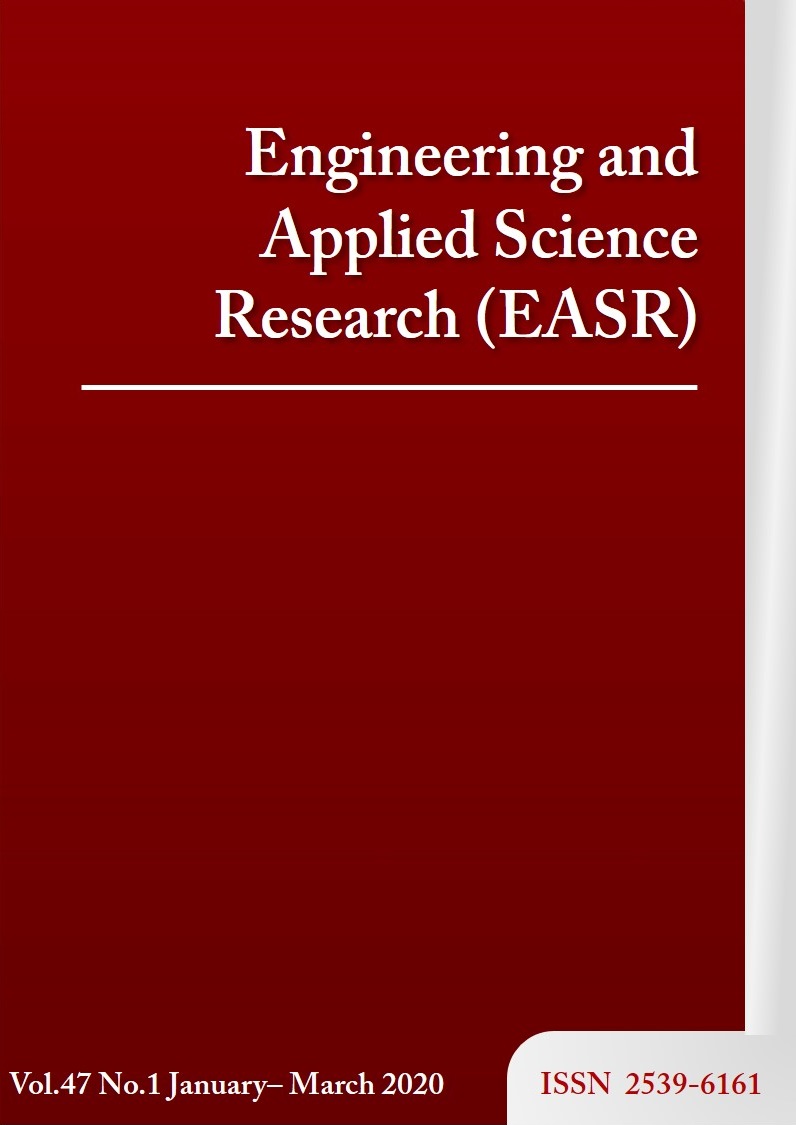Effect of suspended solids removal methods on methane production from tapioca starch wastewater
Main Article Content
Abstract
This study aims to evaluate methods for removing suspended solids (SS) from tapioca starch wastewater to increase methane producing activity (MPA) and biochemical methane potential (BMP). Three methods for SS removal, filtration, centrifugation, and settling, were compared using raw wastewater that had a high SS concentration of over 3,000 mg/L. Filtration was found to be the best method and it increased the MPA by 44% while removing 100% of the SS. Centrifugation and gravity settling had substantial effects, increasing BMP by 7.7% and 6.1% and removing 98.4% and 15.5% of SS, respectively. While the SS concentration is the main factor for determining the success of an up-flow anaerobic sludge bed (UASB) system, this study showed that the carbohydrate to protein ratio signifies that the biochemical component of the wastewater is a key factor causing increases in MPA and BMP. The SS removal methods used in this study also led to higher carbohydrate/COD and protein/COD ratios, which can increase MPA and BMP values relative to conditions where SS removal is not performed.
Article Details
This work is licensed under a Creative Commons Attribution-NonCommercial-NoDerivatives 4.0 International License.
References
Chavalparit O, Ongwandee M. Clean technology for the tapioca starch industry in Thailand. J Clean Prod. 2009;17(2):105-10.
Breuninger WF, Piyachomkwan K, Sriroth K. Chapter 12 - Tapioca/Cassava Starch: Production and Use. In: BeMiller J, Whistler R, editors. Starch. 3rd ed. San Diego: Academic Press; 2009. p. 541-68.
Annachhatre AP, Amatya PL. UASB Treatment of Tapioca Starch Wastewater. J Environ Eng. 2000; 126(12):1149-52.
Rajbhandari BK, Annachhatre AP. Anaerobic ponds treatment of starch wastewater: Case study in Thailand. Bioresour Technol. 2004;95(2):135-43.
Suwanasri K, Trakulvichean S, Grudloyma U, Songkasiri W, Commins T, Chaiprasert P, et al. Biogas-Key Success Factors for Promotion in Thailand. J Sustain Energy Environ. 2015:25-30.
Lettinga G, Hulshoff Pol LW. UASB-Process Design for Various Types of Wastewater. Water Sci Technol. 1991;24(8):87-107.
Ganidi N, Tyrrel S, Cartmell E. Anaerobic digestion foaming causes - a review. Bioresour Technol. 2009;100(23):5546-54.
Subramanian B, Pagilla KR. Colloids and surfaces B: biointerfaces mechanisms of foam formation in anaerobic digesters. Colloids Surfaces B Biointerfaces. 2015;126:621-30.
Baird RB, Bridgewater L, Clesceri LS, Eaton AD, Rice EW, editors. Standard methods for the examination of water and wastewater. USA: American public health association; 2012.
Nielsen SS. Phenol-Sulfuric Acid Method for Total Carbohydrates. In: Nielsen S.S, editor. Food analysis laboratory manual. Boston: Springer; 2010. p. 47-53.
Lowry OH, Rosebrough NJ, Farr AL, Randall RJ. Protein measurement with the folin phenol reagent. J Biol Chem. 1951;193:265-75.
Syutsubo K, Sinthurat N, Ohashi A, Harada H. Population dynamics of anaerobic microbial consortia in thermophilic granular sludge in response to feed composition change. Water Sci Technol. 2001;43(1):59-66.
Harada H, Uemura S, Momonoi K. Interaction between sulfate-reducing bacteria and methane-producing bacteria in UASB reactors fed with low strength wastes containing different levels of sulfate. Water Res. 1994;28(2):355-67.
Chaiprasert P, Hudayah N, Auphimai C. Efficacies of Various anaerobic starter seeds for biogas production from different types of wastewater. Biomed Res Int. 2017;2017:1-13.
Avancini SRP, Faccin GL, Vieira MA, Rovaris AA, Podestá R, Tramonte R, et al. Cassava starch fermentation wastewater: Characterization and preliminary toxicological studies. Food Chem Toxicol. 2007;45(11):2273-8.
Buffiere P, Loisel D, Bernet N, Delgenes JP. Towards new indicators for the prediction of solid waste anaerobic digestion properties. Water Sci Technol. 2006;53(8):233-41.
Angelidaki I, Sanders W. Assessment of the anaerobic biodegradability of macropollutants. Rev Environ Sci Biotechnol. 2004;3(2):117-29.
Christ O, Wilderer PA, Angerhöfer R, Faulstich M. Mathematical modeling of the hydrolysis of anaerobic processes. Water Sci Technol. 2000;41(3):61-5.



